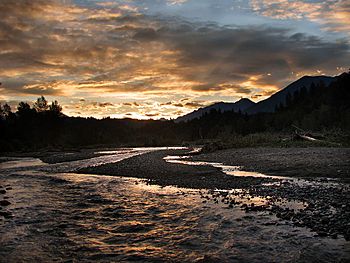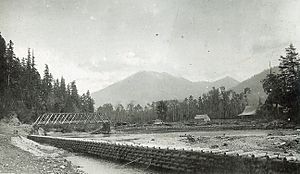Vedder River facts for kids
Quick facts for kids Vedder River |
|
|---|---|

The Vedder River, in Chilliwack, BC.
|
|
| Other name(s) | Chilliwack River |
| Country | Canada, United States |
| Province | British Columbia |
| State | Washington |
| Physical characteristics | |
| Main source | Hannegan Pass 48°53′3″N 121°31′42″W / 48.88417°N 121.52833°W |
| River mouth | Sumas River 49°08′N 122°06′W / 49.133°N 122.100°W |
| Length | 80 km (50 mi) |
| Basin features | |
| Basin size | 1,230 km2 (470 sq mi) |
The Vedder River is a river that flows through British Columbia, Canada, and Washington, USA. It is also known as the Chilliwack River in its upper parts, especially before it reaches a place called Vedder Crossing.
The name "Chilliwack" comes from the Halkomelem language. The word Tcil'Qe'uk means "valley of many streams." This name perfectly describes the area where the river flows.
Contents
Where Does the Vedder River Flow?
The Vedder River starts as the Chilliwack River in Washington state. It begins high up in the North Cascades National Park, near Hannegan Pass. From there, it flows north and crosses the border into Canada.
Journey Through Chilliwack Lake
The river then flows into Chilliwack Lake. Before it reaches the lake, it passes through a deep and tricky area called Hells Gorge. Here, the river drops over a waterfall. The Little Chilliwack River also joins it before the border.
There used to be a large sandy beach where the river enters Chilliwack Lake. This was a popular spot for people to visit. However, now access is limited, and the south shores of the lake are protected as a special ecological reserve.
From Lake to Other Rivers
The river leaves the north end of Chilliwack Lake. It then flows west through the Chilliwack River Valley. It eventually reaches the flat lands near the city of Chilliwack.
At a spot called Vedder Crossing, the Sweltzer River joins it. After this point, the river's name changes to the Vedder River. It then flows west and north to meet the Sumas River. The Sumas River then flows into the larger Fraser River.
The Vedder Canal: Protecting Farmlands
From Vedder Crossing, the Vedder River flows through the Vedder Canal. This canal helps control the river's water, especially during spring floods. It stops the river from overflowing and flooding nearby farms and towns. The canal was also part of a big project that drained Sumas Lake, turning it into Sumas Prairie.
The Vedder River also forms a natural boundary. Downstream from the Vedder Crossing Bridge, it separates the communities of Yarrow to the south and Greendale to the north. Both are now part of the City of Chilliwack.
How the River Changed Over Time
Long ago, the Chilliwack River flowed north from Vedder Crossing straight to the Fraser River. But in 1875, heavy rains caused a huge pile of logs to block the river. This made the river split into two smaller streams.
New Paths and Canals
Later, in 1882, another logjam was made on purpose. This caused the river to change direction and flow west into what was then Sumas Lake. A big flood in 1894 made this new path permanent.
In the early 1900s, people built dikes and canals to control the river. Today, the Chilliwack River becomes the Vedder River at Vedder Crossing. Farther downstream, it becomes the Vedder Canal. This canal was built in the 1920s to help drain Sumas Lake. The old path of the Chilliwack River is now called Chilliwack Creek. It still flows north to the Fraser River.
Exploring the Border
The Chilliwack River was very important for the Northwest Boundary Survey between 1857 and 1862. This survey helped map the border between the United States and British-Canadian lands. Many smaller streams that feed the Chilliwack River cross this border.
Both American and British survey teams set up camps on Chilliwack Lake. From there, they explored the river's area and even went east to the Skagit River. Also, an old trail called the Whatcom Trail followed much of the Chilliwack River's path.
Fun Activities on the Vedder River
The Vedder/Chilliwack River is special because it has strong whitewater rapids. This makes it a very popular place for whitewater kayaking and river rafting all year round.
Relaxing by the River
The parts of the river downstream from the Vedder Bridge are great for relaxing. Many locals enjoy swimming, sunbathing, and having campfires on the river banks.
The Vedder River Campground is a popular spot for camping. It is open from April 1 to October 31 each year.
Fishing in the River
The Vedder-Chilliwack River is famous for its excellent fishing. In the fall, you can find different types of salmon, including chinook, coho, chum, pink, and sockeye salmon. In winter and spring, people come to fish for steelhead.
A Place for Sports History
The Vedder Canal was even used for the 1954 British Empire and Commonwealth Games. The rowing events were held there. Canadian athletes won bronze medals in single and double sculls, and a gold medal in eights rowing.
Major Streams Joining the River
Many smaller streams, called tributaries, flow into the Vedder/Chilliwack River.
Tributaries in the United States
- Indian Creek
- Bear Creek
- Little Chilliwack River
Tributaries in Canada
- Centre Creek
- Nesakwatch Creek
- Foley Creek
- Chipmunk Creek
- Slesse Creek
- Tamihi Creek
- Liumchen Creek
- Sweltzer River
See also
 In Spanish: Río Vedder para niños
In Spanish: Río Vedder para niños



